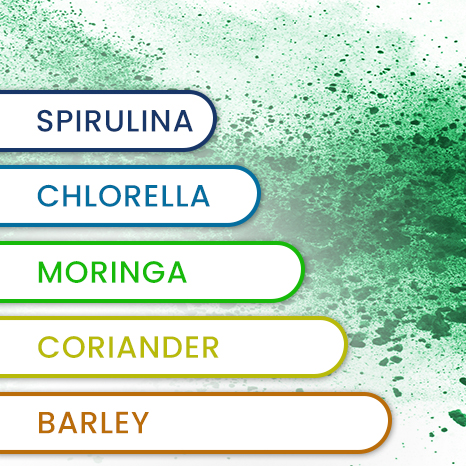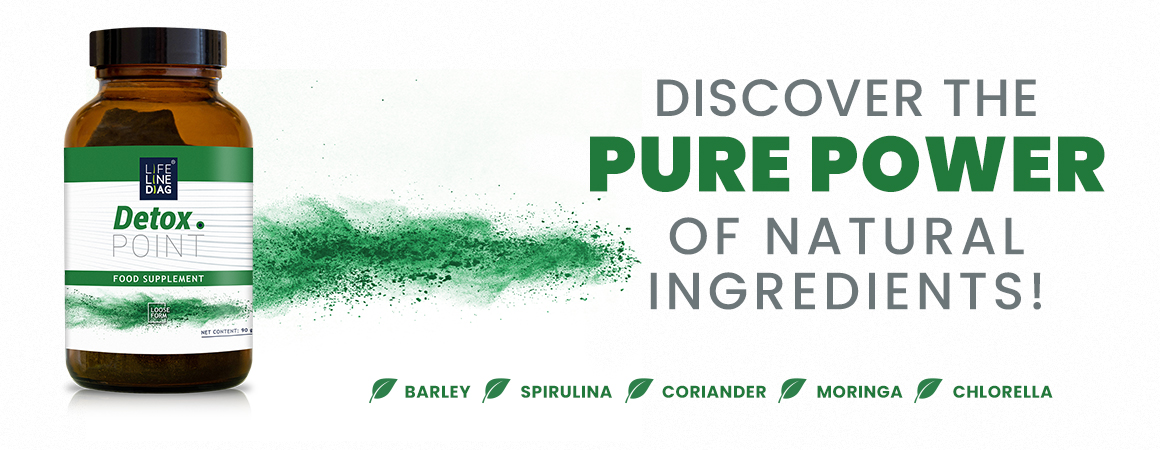
Superfoods are considered to be foods that are particularly rich in nutrients and antioxidants and are attributed with beneficial health properties. Although this group includes some fish and other food products, it primarily consists of plants.
Some key superfoods include moringa (Moringa oleifera Lam.), coriander (Coriandrum sativum L.), barley (Hordeum vulgare L.), chlorella (Chlorella vulgaris Beijerinck), and spirulina (Spirulina plantis). .
WHAT CONNECTS THESE INGREDIENTS? WHY DOES USING THEM IN COMBINATION MAXIMIZE THEIR EFFECTIVENESS?
Nutritional Value
All of the mentioned plants are rich in vitamins, minerals, protein, amino acids, antioxidants, and other beneficial nutrients for the human body.
Source of Protein
Moringa, barley, chlorella, and spirulina are recognized as high-quality sources of plant-based protein. Therefore, they can serve as a substitute for animal protein and, as a result, provide an alternative for vegans and vegetarians.
Supporting the Body
Each of these plants is associated with benefits such as strengthening the immune system, detoxifying the body from toxins, aiding digestion, and reducing inflammation.
Detoxification
These plants are particularly known for their ability to bind and remove toxins from the body, including heavy metals.
THE DETOXIFYING POWER OF SUPERFOODS COMBINATION
Detoxification refers to the process of removing harmful toxins, pollutants, and other unfavorable substances from the body or neutralizing their effects. It is a natural process that occurs in the human body thanks to the work of the liver, kidneys, lungs, and skin, which together neutralize and eliminate toxins from the body. The goal of detoxification is to optimize the body’s functioning and support homeostasis.
Regardless of our lifestyle, every organism is to some extent exposed to the harmful effects of substances that accumulate in the body. Therefore, actively supporting the detoxification process is absolutely beneficial for our body. This is where superfoods come into play, as they are characterized by their detoxifying properties.
YOUNG BARLEY
It contains many nutrients, including vitamins, minerals, amino acids, antioxidants, and enzymes that can support the body’s health and its natural detoxification mechanisms.Below are some components of young barley associated with potential detoxification benefits:
- Chlorophyll , responsible for its characteristic green color, is considered a natural cleanser of the body that can help remove toxins, neutralize free radicals, and support liver health.
- Antioxidants , such as vitamin C, vitamin E, beta-carotene, and superoxide dismutase (SOD) help combat the effects of free radicals and protect cells from oxidative damage.
- Fiber , which can support digestion and the elimination of toxins from the gastrointestinal tract.
- Enzymes , such as superoxide dismutase (SOD), which aid in detoxification by neutralizing free radicals.
Antioxidant Properties
„[…] In conditions of homeostasis, the production of reactive oxygen species (ROS) in the body is tightly controlled. Even a slight disruption in the balance between oxidative potential and antioxidants leads to the accumulation of ROS and, consequently, the occurrence of so-called oxidative stress. The harmfulness of ROS stems from their high reactivity; by reacting with proteins, lipids, and nucleic acids, they disrupt their proper structure and functions, ultimately leading to the death of cells exposed to them. Prolonged exposure of the body to oxidative stress is a cause of many diseases, including cancer and neurodegenerative diseases.
Therefore, enriching your daily diet with antioxidant-rich foods is crucial. An excellent source of antioxidants can be young barley, which contains, among other things, O-glycosyl isovitexin (2-O-GIV, 2-O-glycosyl isovitexin), superoxide dismutase (SOD), catalase (CAT), peroxidase (POX), vitamins E and C, carotenoids, and chlorophyll.
Similar to nutrients, the composition and quantity of antioxidants depend on the part of the grain and the form in which it is consumed. Ferreres et al. examined the phenolic profile of barley, including its leaves, seeds, spikes, and stems, identifying a total of 28 compounds: 26 flavonoids, 2 derivatives of phenolic acids, and lutonarin. The leaves were found to be the most heterogeneous in terms of the content of these substances. Lee et al., in their research using leaf extract, demonstrated its ability to scavenge free radicals, partly attributed to the presence of superoxide dismutase (SOD) in the analyzed fraction.[…]
It has been proven that isolated from ethanolic barley grass extract, isoflavonoid glycosyl isovitexin inhibits the formation of malondialdehyde (one of the final products of lipid oxidation) more effectively than α-tocopherol. It also exhibits stronger antioxidant properties in relation to omega-3 fatty acids, such as eicosapentaenoic acid (EPA), than commonly known antioxidants (α-tocopherol or β-carotene). Subsequent studies conducted by Markham and Mitchell revealed that the main antioxidants in young barley leaves are C-glycosides of flavonoids, saponarin, and lutonarin. These two unique flavonoid glycosides isolated from barley grass—saponarin (7-O-GIV) and lutonarin (7-O-GIO)—also participate in inhibiting the formation of malondialdehyde. Studies carried out by Kamiyama and Shibamoto not only confirmed the antioxidant activity of these substances but also allowed for the conclusion that supplementation with young barley containing 7-O-GIV could prevent diseases caused by ROS-induced damage, including, among others, cancer and cardiovascular diseases. […]” 1
SPIRULINA
It contains a high amount of protein, vitamins (such as vitamin B12, vitamin K), minerals (iron, copper, manganese), and antioxidants (such as beta-carotene and phycocyanin). Antioxidants help neutralize harmful free radicals that can be generated during metabolic processes or as a result of oxidative stress, which is associated with detoxification processes.
Spirulina can also support liver health, which is a crucial organ responsible for detoxification. Some animal studies suggest that spirulina may help protect the liver from toxins and oxidative damage.
Antioxidant Properties
“The antioxidant properties attributed to spirulina stem from the presence of phenolic acids, tocopherols, and beta-carotene. The antioxidant activity of spirulina has been demonstrated both in vitro (in a test tube) and in vivo (in living organisms). Spirulina is a rich source of protein, containing about 5 times more protein than meat. It is also a significant source of calcium (180% more Ca than in whole milk), beta-carotene (3100% more than in carrots), and iron (5100% more than in spinach). Therefore, it is a highly valuable product that allows significant amounts of essential nutrients to be supplied to the body even through the consumption of small portions. Laboratory studies conducted on human cells have observed that in the presence of toxic concentrations of iron, spirulina chelates iron, reducing induced oxidative stress. In geriatric patients who were given spirulina for 16 weeks, significantly increased levels of antioxidants were observed in their blood serum.”2
CORIANDER (Coriandrum sativum)
It is often associated with detoxifying the body. The leaves, stems, and seeds of coriander contain various nutrients such as vitamins (e.g., vitamin A, vitamin C, vitamin K), minerals (e.g., iron, magnesium), fiber, and antioxidants.Coriander has several properties that can influence detoxification:
- Supports the liver , due to the presence of phytochemicals that can support the liver and improve its detoxification capacity.
- Contains antioxidants such as polyphenols and carotenoids, which help neutralize free radicals in the body and protect cells from oxidative damage.
- Coriander is also considered a plant that can help support digestive health , which can have a positive impact on the detoxification of the body.
Antioxidant Properties
„[…]Antioxidants play an important role in the promotion of cardiovascular health since oxidative stress that inflicts the myocardium can be associated with the incidence of atherosclerosis, which increases the risk of coronary artery disease. C. sativum has been demonstrated in many studies to possess a pronounced antioxidant activity, and this is mainly due to the activity of polyphenols, vitamins, and sterol constituents of coriander.[…]
Another potential antioxidant mechanism is associated with the high levels of polyphenol in the leaf extract of C. sativum, which acts as a free radical scavenger, thus preventing oxidative damage to the myocardial tissues. Free radicals are highly reactive; for instance, hydroxyl radicals can cause damage to membrane phospholipids, DNA, and proteins, in which the former would result in the formation of peroxyl radicals. Thus, when there are insufficient natural antioxidant components in the body, such as superoxide dismutase (SOD) enzyme and glutathione peroxidase (GSH-px), an oxidative chain reaction may occur, resulting in tissue damage. However, it has been reported that this strong antioxidant potential of coriander may also be due to the synergistic effect of the combination of different antioxidant compounds, such as tocopherols and sterols.[…]” 3
“[…]Furthermore, the consumption of Coriandrum sativum contributes to an increase in the concentration of bile acids and sterols in the liver and feces, indicating enhanced hepatic cholesterol degradation. This action is likely associated with the increased activity of hepatic 7a-hydroxylase. […]” 4
„„It was found that Coriandrum sativum extract decreased proinflammatory cytokine TNF-α and apoptotic cell death and liver enzymes in liver ischaemia/reperfusion injury.” 5
MORINGA
Moringa contains vitamins (A, C, E, K, B-complex), minerals (calcium, iron, magnesium, potassium), amino acids, antioxidants, and phytochemicals.
Here are some properties of moringa that are associated with its impact on detoxification:
- Antioxidantsthat help neutralize free radicals in the body, thereby protecting cells from oxidative damage.
- Supports the functioning of the liver, which is a key organ responsible for detoxifying the body..
- Fiber aids in digestion and the elimination of toxins from the gastrointestinal tract.
Antioxidant properties
„[…]Naturally occurring antioxidants, particularly polyphenols, are the main plant compounds that are able to decrease oxidative damage in tissues by indirect enhancement of a cell or by free radical scavenging (Du et al., 2010). The leaves of the Moringa oleifera tree have been reported to demonstrate antioxidant activity dues to its high amount of polyphenols (Sreelatha and Padma, 2009; Verma et al., 2009). Moringa oleifera extracts of both mature and tender leaves exhibit strong antioxidant activity against free radicals, prevent oxidative damage to major biomolecules and give significant protection against oxidative damage.
A comparative study indicated that mature Moringa oleifera leaf extract exhibited better values of enzymatic and non-enzymatic antioxidants. In the DPPH (2,2-Diphenyl- 1-Picrylhydrazyl) free radical scavenging activity test, both mature and tender leaf extracts showed significant reduction of DPPH radicals. […]
A further TLC (Thin layer chromatography) analysis was conducted to identify the chemical nature of active compounds which were possibly providing these antioxidant protection properties. According to Sreelatha and Padma (2009), qualitative analysis of the extracts revealed the presence of phenolics, flavonoids and trace amounts of alkaloids, in both mature and tender leaves.
Similarly, another study by Siddhuraju and Becker (2003) using the same DPPH assay to determine the antioxidant activity, revealed that the extracts of Moringa leaf samples from three different agroclimatic origins had very high radical scavenging activity. It was stated that generally, the higher the total polyphenols, the higher the antioxidant activity, in which it is most likely to be due to the combined action of several existing substances as well as the high hydrogen donating ability. […]” 6
CHLORELLA
Chlorella is rich in nutrients, such as protein, vitamins (A, B-complex, C, E, K), minerals (iron, magnesium), fiber, antioxidants, and chlorophyll.
Here are several properties of chlorella associated with its potential impact on detoxification:
- Detoxification of Heavy Metals, It is often associated with the ability to bind heavy metals like lead, mercury, cadmium, and arsenic and assist in their elimination from the body. Due to its structure, chlorella has the capability to bind with toxins and heavy metals, which can then be expelled from the body.
- Liver Support, it supports the liver, which is a key organ responsible for detoxifying the body. Components found in chlorella may help protect the liver from oxidative damage and support its detoxification functions.
- Antioxidants, Chlorella’s antioxidants help neutralize free radicals and protect cells from oxidative damage.
- Fiber It aids in digestion and the elimination of toxins from the gastrointestinal tract.
Antioxidant Action
„The presented results revealed great chemopreventive properties of young green barley and chlorella water extract, as well as their combination in in vitro model of colon cancer. Used together or separately, the studied extracts specifically inhibited the proliferation of human colon cancer cells without any undesirable effect on human colon epithelial cells. Furthermore, the presented anticancer properties of the extracts were significantly enhanced after combination, without increasing their toxicity against normal cells.
The beneficial effect of combined / simultaneous use of young green barley and chlorella seems to be attributed to the complex mixture of phytochemicals present in the studiem product; however, further chemical research is required to determine the bioactive compounds. Nevertheless, it needs to be highlighted that the presented study is the first evidence of the anticancer properties of the combination of one of the most popular new superfoods. Furthermore, because of the increasing consumption of these products, further research on the health benefits of their phytochemicals, as well as whole specimens, is warranted. The presented positive results will provide a rationale for the development a new chemopreventive strategy.” 7
Lifeline Diag
Bibliography:
1.„Prozdrowotne właściwości młodego jęczmienia.”; Kawka K, Lemieszek M K.; Med. Og. Nauk Zdr. 2017; 23(1): 7–12. doi: 10.5604/20834543.1235619; https://www.monz.pl/Prozdrowotne-wlasciwosci-mlodego-jeczmienia,73682,0,1.html
2.„Superfoods – idealne uzupełnienie diety czy zbędny dodatek?”; Katarzyna Ekiert, Marta Dochniak; Uniwersytet Medyczny im Piastów Śląskich we Wrocławiu; Piel. Zdr. Publ. 2015, 5, 4, 401–408; DOI: 10.17219/pzp/60915; ISSN 2082-9876; https://pzp.umw.edu.pl/pdf/2015/5/4/401.pdf 3.Newborns, Proc. Natl. Acad. Sci. USA, 107 (26), 2010, s. 11971-11975
3.„Coriandrum sativum L.: A Review on Ethnopharmacology, Phytochemistry, and Cardiovascular Benefits.”;
Nisa Najibah Mahleyuddin, Said Moshawih, Long Chiau Ming, Hanis Hanum Zulkifly, Nurolaini Kifli, Mei Jun Loy, Md. Moklesur Rahman Sarker, Yaser Mohammed Al-Worafi, Bey Hing Goh, Shobna Thuraisingam, Hui Poh Goh1; 3.12.2021 r.; https://www.ncbi.nlm.nih.gov/pmc/articles/PMC8747064/
4.„Znaczenie wybranych przypraw w chorobach sercowo-naczyniowych”; Bartosz Kulczyński, Anna Gramza-Michałowska; Katedra Technologii Żywienia Człowieka, Wydział Nauk o Żywności i Żywieniu Uniwersytet Przyrodniczy w Poznaniu; 14.11.2016 r; https://phmd.pl/resources/html/article/details?id=142507&language=en
5.„Protective effect of Coriandrum sativum extract against inflammation and apoptosis in liver ischaemia/reperfusion injury.”; A. Kükner1, G. Soyler2, P. Toros1, G. Dede3, F. Meriçli4, S. Işık5, O. Edebal6, C. Özoğul7; 29.05.2020 r.; https://journals.viamedica.pl/folia_morphologica/article/view/68338.
6.„Health Benefits of Moringa oleifera”; Ahmad Faizal Abdull Razis, Muhammad Din Ibrahim, Saie Brindha Kntayya; Asian PacificJournal odf Cancer Prevention, Vol 15, 2014; http://koreascience.or.kr/article/JAKO201435648479194.page
7. „Enhancement of chemopreventive properties of young green barley and chlorella extracts used together against colon cancer cells”; Marta Kinga Lemieszek , Wojciech Rzeski; Department of Medical Biology, Institute of Rural Health, Lublin, Poland; Annals of Agricultural and Environmental Medicine 2020, Vol 27, No 4; https://www.aaem.pl/Enhancement-of-chemopreventive-properties-of-young-green-barley-and-chlorella-extracts,130555,0,2.html









